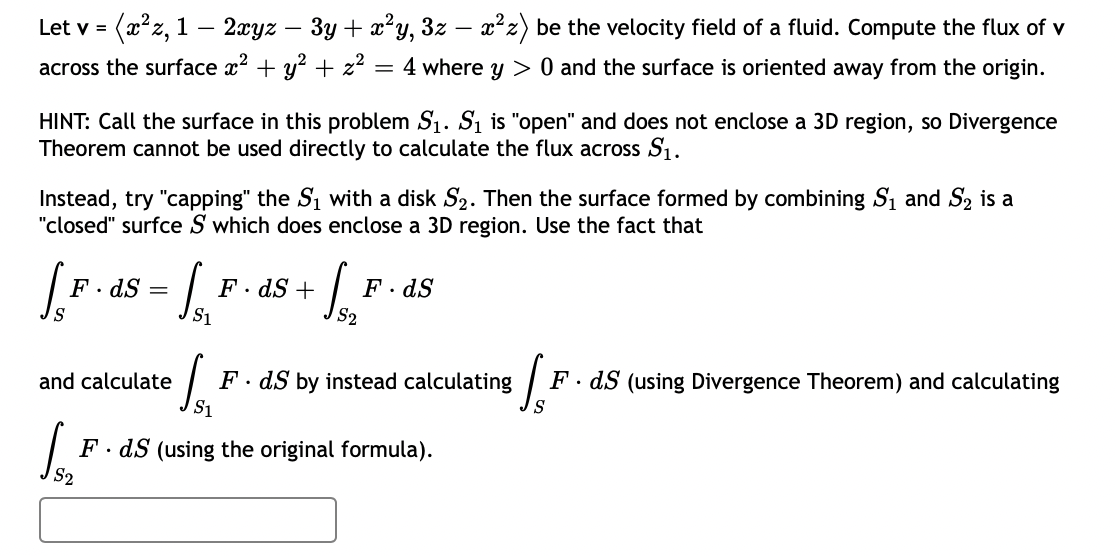Let v = (x²z, 1 – 2xyz – 3y + x²y, 3z - x²z) be the velocity field of a fluid. Compute the flux of v across the surface x? + y? + z² = 4 where y > 0 and the surface is oriented away from the origin. HINT: Call the surface in this problem S1. Sı is "open" and does not enclose a 3D region, so Divergence Theorem cannot be used directly to calculate the flux across S1. Instead, try "capping" the S1 with a disk S2. Then the surface formed by combining S1 and S2 is a "closed" surfce S which does enclose a 3D region. Use the fact that F. dS = F· dS + F· dS and calculate F· dS by instead calculating F. dS (using Divergence Theorem) and calculating S1 S F· dS (using the original formula).
Let v = (x²z, 1 – 2xyz – 3y + x²y, 3z - x²z) be the velocity field of a fluid. Compute the flux of v across the surface x? + y? + z² = 4 where y > 0 and the surface is oriented away from the origin. HINT: Call the surface in this problem S1. Sı is "open" and does not enclose a 3D region, so Divergence Theorem cannot be used directly to calculate the flux across S1. Instead, try "capping" the S1 with a disk S2. Then the surface formed by combining S1 and S2 is a "closed" surfce S which does enclose a 3D region. Use the fact that F. dS = F· dS + F· dS and calculate F· dS by instead calculating F. dS (using Divergence Theorem) and calculating S1 S F· dS (using the original formula).
Calculus: Early Transcendentals
8th Edition
ISBN:9781285741550
Author:James Stewart
Publisher:James Stewart
Chapter1: Functions And Models
Section: Chapter Questions
Problem 1RCC: (a) What is a function? What are its domain and range? (b) What is the graph of a function? (c) How...
Related questions
Question

Transcribed Image Text:(2²z, 1 – 2xyz
- 3y + x?y, 3z – x² z) be the velocity field of a fluid. Compute the flux of v
Let v =
across the surface x2 + y? + z?
4 where y > 0 and the surface is oriented away from the origin.
HINT: Call the surface in this problem S1. Si is "open" and does not enclose a 3D region, so Divergence
Theorem cannot be used directly to calculate the flux across S1.
Instead, try "capping" the S1 with a disk S2. Then the surface formed by combining S1 and S2 is a
"closed" surfce S which does enclose a 3D region. Use the fact that
F. dS
F · dS +
F· dS
S1
F. dS by instead calculating
S1
S.
and calculate
F· dS (using Divergence Theorem) and calculating
F. dS (using the original formula).
Expert Solution
This question has been solved!
Explore an expertly crafted, step-by-step solution for a thorough understanding of key concepts.
This is a popular solution!
Trending now
This is a popular solution!
Step by step
Solved in 2 steps with 2 images

Recommended textbooks for you

Calculus: Early Transcendentals
Calculus
ISBN:
9781285741550
Author:
James Stewart
Publisher:
Cengage Learning

Thomas' Calculus (14th Edition)
Calculus
ISBN:
9780134438986
Author:
Joel R. Hass, Christopher E. Heil, Maurice D. Weir
Publisher:
PEARSON

Calculus: Early Transcendentals (3rd Edition)
Calculus
ISBN:
9780134763644
Author:
William L. Briggs, Lyle Cochran, Bernard Gillett, Eric Schulz
Publisher:
PEARSON

Calculus: Early Transcendentals
Calculus
ISBN:
9781285741550
Author:
James Stewart
Publisher:
Cengage Learning

Thomas' Calculus (14th Edition)
Calculus
ISBN:
9780134438986
Author:
Joel R. Hass, Christopher E. Heil, Maurice D. Weir
Publisher:
PEARSON

Calculus: Early Transcendentals (3rd Edition)
Calculus
ISBN:
9780134763644
Author:
William L. Briggs, Lyle Cochran, Bernard Gillett, Eric Schulz
Publisher:
PEARSON

Calculus: Early Transcendentals
Calculus
ISBN:
9781319050740
Author:
Jon Rogawski, Colin Adams, Robert Franzosa
Publisher:
W. H. Freeman


Calculus: Early Transcendental Functions
Calculus
ISBN:
9781337552516
Author:
Ron Larson, Bruce H. Edwards
Publisher:
Cengage Learning